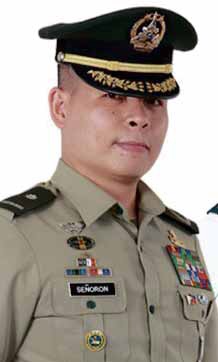Metrobank’s Outstanding Filipinos: Bomb ‘disruptor’ saves lives
After seeing soldiers lose life and limb from detonating enemy bombs, a young military officer did the next best thing: assemble a “disruptor” out of small blasting caps and water canister.
The revolutionary device has been saving the lives not only of Army officers and men, but also civilians in conflict areas.
“If I was able to design and develop devices for use of the AFP (Armed Forces of the Philippines) considering the limited resources that I had at the time, I am certain that there are equally capable Filipinos working in the public and private sectors that could work together given the appropriate support and proper management for the same purpose,” Lt. Col. Francis Señoron said at Friday’s awarding of Metrobank Foundation Outstanding Filipinos.
For his invention and other accomplishments, the 40-year-old Army lieutenant colonel was among the 10 recipients of the annual award that recognizes Filipinos who “render service above and beyond their call of duty.”
The other awardees were two soldiers, three policemen and four teachers, who each received P1 million cash, a trophy and a gold medallion.
Article continues after this advertisementUltimate sacrifice
Article continues after this advertisementIn 2006 when he was assigned to the Army’s bomb disposal unit, Señoron saw firsthand how many soldiers paid the ultimate sacrifice of trying to defuse enemy bombs with inadequate equipment.
And with his background in mechanical engineering, he designed and assembled an improvised explosive device (IED) disruptor using readily available and locally sourced materials.
In no time, his invention became widely used and known in the field.
It was even featured in the 2010 report of The Economist magazine, which wrote: “[Señoron], an Army captain, has built IED disruptor out of small blasting caps and a water canister the size of a beer can. When positioned close to a device and detonated remotely with a wire, the canister squirts water into the circuitry of the device to short it out.”
Cheaper design
An IED disruptor can cost around P850,000 each overseas. But using Señoron’s design, such a device can be assembled for P600.
Speaking on behalf of the Metrobank awardees, the Army officer believed in the potential of Filipinos to conduct research and to develop modern technologies for the use of their countrymen.
The country, he added, can only attain development if it is “guided with a deep sense of nationalism.”
He noted how the Philippines, “despite being independent is still militarily dependent on foreign countries.”
Other countries had taken interest in his invention but Señoron chose the Philippine Army to adopt it—along with an electric blasting galvanometer he also designed—for funding and mass local production.
To this day, the two devices are being used by various explosives and ordnance units nationwide, saving not just soldiers but also civilians living in conflict zones.
The other Metrobank awardees were Air Force Lt. Col. Thomas Ryan Seguin and Navy Lt. Col. Danilo Facundo; SPO1 Aida Awitin, Senior Insp. Dennis Ebsolo and Senior Supt. Pascual G. Muñoz Jr.; and teachers Mary Jane Ramo of Tonggo Elementary School, Misamis Occidental, Alma Janagap of Pavia National High School, Iloilo, Aimee Marie Gragasin of Philippine Science High School-Cagayan Valley campus, and Carla Dimalanta of the University of the Philippines Diliman.
